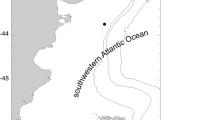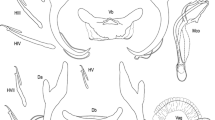Abstract
Rhynchospio glandulosa sp. nov. inhabits silty tubes on muddy sand intertidally and in shallow water in the Yellow Sea, Sea of Japan (East Sea), and the Sea of Okhotsk (Korea, China, and Russia). Adults are up to 9 mm long, 1 mm wide for 62 chaetigers, with characteristic groups of glandular cells in the bases of branchiae from chaetiger 7 to chaetigers 14–23. Individuals with 29–40 chaetigers have mature spermatozoa in chaetigers 11–12 or 11–13, while larger worms are simultaneous hermaphrodites with sperm in chaetigers 11–14 and oocytes from chaetiger 16 to chaetigers 22–42. The oocytes are about 120 µm in diameter, with thin and smooth envelopes. The spermatozoa have a small subspherical acrosome about 1 µm long, a tusk-like nucleus 3–4 µm long, small midpiece with subspherical mitochondria, and a flagellum 45–47 µm long. Early larvae develop on the parent’s dorsum from chaetigers 21–27 to chaetigers 30–36, where they are loosely held by flat branchiae and long dorsal capillaries. After utilizing internal egg yolk, the 4-chaetiger larvae 250–280 µm long escape from the parent and continue its development in sea water, feeding on the plankton. About 2 weeks after hatching, the 11-chaetiger larvae 550–570 µm long get ready for settlement and metamorphosis. Rhynchospio glandulosa sp. nov. is one of the seven Rhynchospio species (12 species described so far) known as simultaneous hermaphrodites and one of the three species known to brood their larvae on the parent’s dorsum. The arrangement of male segments and sperm morphology are suggested as important taxonomic characters for the identification of Rhynchospio species. Feeding mechanism of the planktotrophic Spionidae larvae is briefly discussed.







Similar content being viewed by others
References
Abe H, Sato-Okoshi W (2021) Molecular identification and larval morphology of spionid polychaetes (Annelida: Spionidae) from northeastern Japan. Zookeys 1015:1–86. https://doi.org/10.3897/zookeys.1015.54387
Blake JA (1969) Reproduction and larval development of Polydora from northern New England (Polychaeta: Spionidae). Ophelia 7:1–63
Blake JA (2017) Larval development of Polychaeta from the northern California coast. Fourteen additional species together with seasonality of planktic larvae over a 5-year period. J Mar Biol Assoc U K 97:1081–1133. https://doi.org/10.1017/s0025315417000716
Blake JA, Arnofsky PL (1999) Reproduction and larval development of the spioniform Polychaeta with application to systematics and phylogeny. Hydrobiologia 402:57–106. https://doi.org/10.1023/A:1003784324125
Blake JA, Kudenov JD (1978) The Spionidae (Polychaeta) from southeastern Australia and adjacent areas with a revision of the genera. Mem Natl Mus Vic 39:171–280
Bosc LAG (1802) Histoire naturelle des vers, contenant leur déscription et leurs mœurs; avec figures dessinées d’après nature. Guilleminet, Paris, Tome premier. https://doi.org/10.5962/bhl.title.59169
Chlebovitsch VV (1959) Species of Polychaeta worms from the Kurile Islands, which are new or recorded for the first time in the USSR fauna. Zool Zh 38:167–181
Claparède E (1868) Les Annélides Chétopodes du Golfe de Naples. Ramboz et Schuchardt, Genève. https://doi.org/10.5962/bhl.title.105355
Daro MH, Polk P (1973) The autecology of Polydora ciliata along the Belgian coast. Neth J Sea Res 6:130–140
Ehlers E (1897) Polychaeten. Ergebnisse der Hamburger Magalhaensischen Sammelreise 1892/93. L. Friederichsen & Co., Hamburg
Foster NM (1971) Spionidae (Polychaeta) of the Gulf of Mexico and the Caribbean Sea. Stud fauna Curaçao 36:1–183
Gibson G, Carver D (2013) Effects of extra-embryonic provisioning on larval morphology and histogenesis in Boccardia proboscidea (Annelida, Spionidae). J Morphol 274:11–23. https://doi.org/10.1002/jmor.20071
Gravely FH (1909) Studies on polychæt larvæ. Q J Microsc Sci 53:597–627
Grube AE (1850) Die Familien der Anneliden. Arch Naturgesch, Berlin 16:249–364
Hannerz L (1956) Larval development of the polychaete families Spionidae Sars, Disomidae Mesnil, and Poecilochaetidae n. fam. in the Gullmar Fjord (Sweden). Zool Bidr Uppsala 31:1–204
Hartman O (1936) New species of Spionidae (Annelida Polychaeta) from the coast of California. Univ Calif Publ Zool 41:45–52
Hartman O (1940) Boccardia proboscidea, a new species of spionid worm from California. J Wash Acad Sci 30:382–387
Imajima M (1991) Spionidae (Annelida, Polychaeta) from Japan. VI. The genera Malacoceros and Rhynchospio. Bull Natl Sci Mus, Tokyo. Ser A (Zool) 17:5–17
Örsted AS (1843) Annulatorum danicorum conspectus. Fasc. I. Maricolæ. Sumtibus Librariæ Wahlianæ, Havniæ [Copenhagen]
Ozolinsh AV (1990) Polychaetous worms (Sedentaria) from soft sediments of the subtidal zone of the Far East Marine Reserve. In: Gulbin VV (ed) Systematics and ecology of organisms from the Far East Marine Reserve. FEB AS USSR, Vladivostok, pp 81–104
Ozolinsh AV, Bagaveeva EV (2004) Annelida. In: Tyurin AN, Drozdov AL (eds) Far-East Marine Biospherical Reserve. Biota. V. 2, vol 2. Dalnauka, Vladivostok, pp 135–146
Pernet B, McArthur L (2006) Feeding by larvae of two different developmental modes in Streblospio benedicti (Polychaeta: Spionidae). Mar Biol (Berlin) 149:803–811. https://doi.org/10.1007/s00227-006-0266-8
Radashevsky VI (2005) On adult and larval morphology of Polydora cornuta Bosc, 1802 (Annelida: Spionidae). Zootaxa 1064:1–24. https://doi.org/10.11646/zootaxa.1064.1.1
Radashevsky VI (2007) Morphology and biology of a new Rhynchospio species (Polychaeta: Spionidae) from the South China Sea, Vietnam, with the review of Rhynchospio taxa. J Nat Hist, London 41:985–997. https://doi.org/10.1080/00222930701376717
Radashevsky VI (2015) Spionidae (Annelida) from Lizard Island, Great Barrier Reef, Australia: the genera Aonides, Dipolydora, Polydorella, Prionospio, Pseudopolydora, Rhynchospio, and Tripolydora. Zootaxa 4019:635–694. https://doi.org/10.11646/zootaxa.4019.1.22
Radashevsky VI, Cárdenas CA (2004) Morphology and biology of Polydora rickettsi (Polychaeta: Spionidae) from Chile. NZ J Mar Fresh Res 38:243–254. https://doi.org/10.1080/00288330.2004.9517234
Radashevsky VI, Malyar VV, Pankova VV, Nuzhdin SV (2016) Molecular analysis of six Rhynchospio Hartman, 1936 species (Annelida: Spionidae) with comments on the evolution of brooding within the group. Zootaxa 4127:579–590. https://doi.org/10.11646/zootaxa.4127.3.10
Radashevsky VI, Neretina TV, Pankova VV, Tzetlin AB, Choi J-W (2014) Molecular identity, morphology and taxonomy of the Rhynchospio glutaea complex with a key to Rhynchospio species (Annelida, Spionidae). Syst Biodivers 12:424–433. https://doi.org/10.1080/14772000.2014.941039
Rouse GW (2000) Bias? What bias? The evolution of downstream larval-feeding in animals. Zool Scr 29:213–236
Simon CA, Williams L-G, Henninger T (2019) A new species of Rhynchospio (Annelida: Spionidae) in South Africa. Mar Biodivers 49:663–672. https://doi.org/10.1007/s12526-017-0842-9
Webster HE (1879) The Annelida Chætopoda of New Jersey. Ann Rep NY St Mus Nat Hist 32:101–128
Wilson DP (1928) The larvae of Polydora ciliata Johnston and Polydora hoplura Claparède. J Mar Biol Assoc U K 15:567–603
Acknowledgments
Our sincere thanks to Vera N. Radashevskaya for help with rearing Rhynchospio larvae. Prof. Jong Seong Khim, School of Earth and Environmental Sciences, Seoul National University, provided some support for this study. We also thank two anonymous reviewers for their important comments which improved the manuscript after submission.
Funding
Financial support was provided by the research project “A taxonomic study of the polychaete worms boring into the shells of marine abalone (PE 9944c)” of the Korea Institute of Ocean Science & Technology (KIOST) and the research project “Marine Ecosystem-based Analysis and Decision-making Support System Development for Marine Spatial Planning (20170325)” of the Ministry of Oceans and Fisheries (MOF), Korea.
Author information
Authors and Affiliations
Corresponding author
Ethics declarations
Conflicts of interest
The authors declare no competing interest.
Ethical approval
All applicable international, national, and/or institutional guidelines for the care and use of animals were followed by the author.
Sampling and field studies
Sampling and field studies were performed using laboratory facilities in South Korea and Russia. All necessary permits for sampling were obtained. The study is compliant with CBD and Nagoya protocols.
Data availability
All sample data reported by this study are included in this published article and its Supplementary Material file.
Author contribution
JWC organized sampling in the field and sample processing in the laboratory. VIR identified spionid polychaetes and wrote the manuscript. Both authors read and approved the manuscript.
Additional information
Communicated by D. Fiege
Publisher's Note
Springer Nature remains neutral with regard to jurisdictional claims in published maps and institutional affiliations.
This article is registered in ZooBank under http://zoobank.org/4037A22B-9075-4F44-AED3-CBE5D4D2D666
Supplementary Information
Below is the link to the electronic supplementary material.
Rights and permissions
About this article
Cite this article
Radashevsky, V.I., Choi, JW. Morphology and reproductive biology of a new hermaphroditic Rhynchospio (Annelida: Spionidae) species brooding larvae on the parent’s dorsum. Mar. Biodivers. 51, 65 (2021). https://doi.org/10.1007/s12526-021-01197-6
Received:
Revised:
Accepted:
Published:
DOI: https://doi.org/10.1007/s12526-021-01197-6




